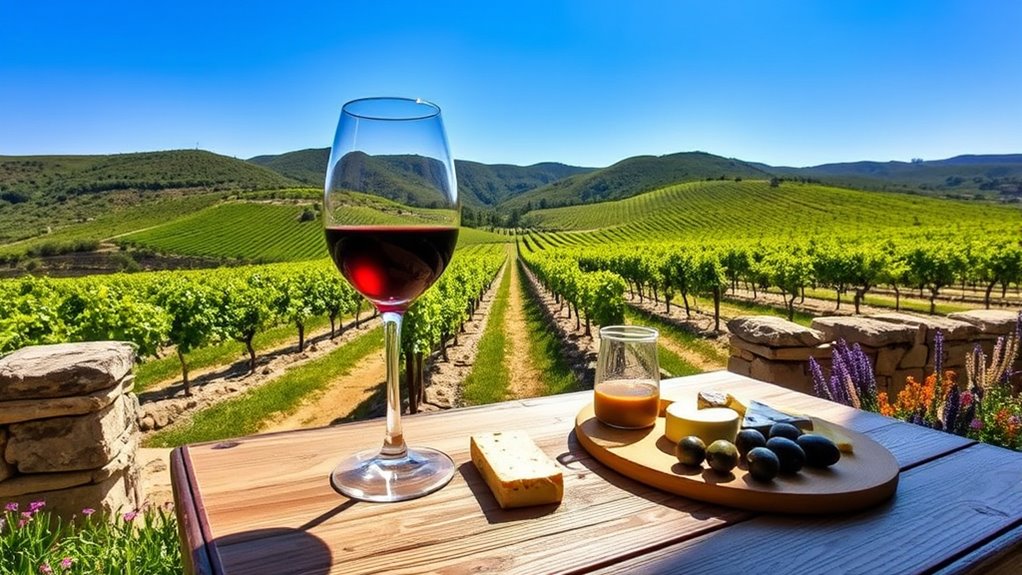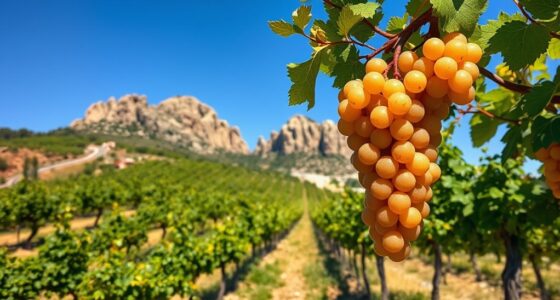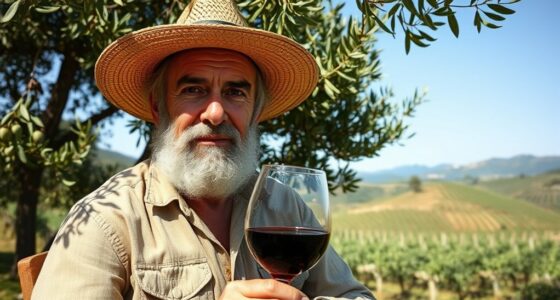In Northern Sardinia, you can explore scenic vineyards producing top-quality Vermentino di Gallura DOCG, renowned for its vibrant aroma, minerality, and perfect pairing with fresh seafood. Visit renowned wineries like Cantina Santa Maria La Palma and Capichera to see traditional and modern techniques. Small-batch producers offer artisanal experiences, and guided tours reveal regional viticulture. Discover how local cuisine complements the wines, making your tasting journey truly unforgettable—if you continue, you’ll uncover even more about this enthralling wine region.
Key Takeaways
- Visit renowned wineries like Cantina Santa Maria La Palma, Capichera, and Vigne Surrau for guided Vermentino tastings.
- Explore scenic vineyard tours in Gallura, enjoying insights into local grape varieties and traditional winemaking techniques.
- Sample regional whites such as Vermentino di Gallura, Nuragus, and Torbato paired with fresh seafood and local delicacies.
- Experience tastings at small artisanal producers focusing on organic, biodynamic practices and authentic Sardinian flavors.
- Best visiting times are late afternoon with advance reservations, allowing for immersive, comfortable wine-tasting experiences.
Exploring the Vermentino Di Gallura DOCG
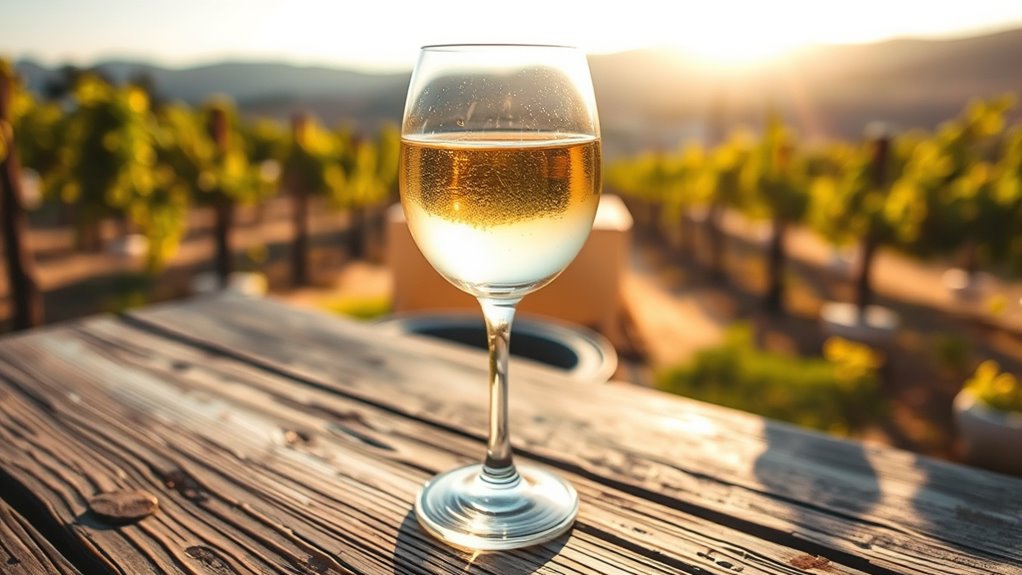
If you’re exploring Sardinian wines, the Vermentino di Gallura DOCG stands out as the island’s premier white wine. It’s the only DOCG white in Sardinia, guaranteeing top quality and strict standards. To qualify, it must contain at least 95% Vermentino grapes from the Gallura region, with a typical alcohol level around 13%. Wines labeled “Superiore” have even tighter yield limits and longer aging requirements. Certification involves rigorous testing to verify typicity, structure, and regional authenticity, with only grapes from designated subzones qualifying. This ensures you’re tasting a wine that truly reflects Gallura’s unique terroir. The result is a vibrant, aromatic wine with a straw yellow hue, fresh white flower and citrus notes, and a mineral, marine undertone that enhances its elegance and complexity. Vermentino di Gallura DOCG is also distinguished by its adherence to environmentally sustainable practices, which help preserve the region’s natural beauty and unique terroir. Additionally, the certification process aligns with quality standards that help maintain the wine’s reputation for excellence and authenticity.
The Unique Terroir of Gallura’s Vineyards
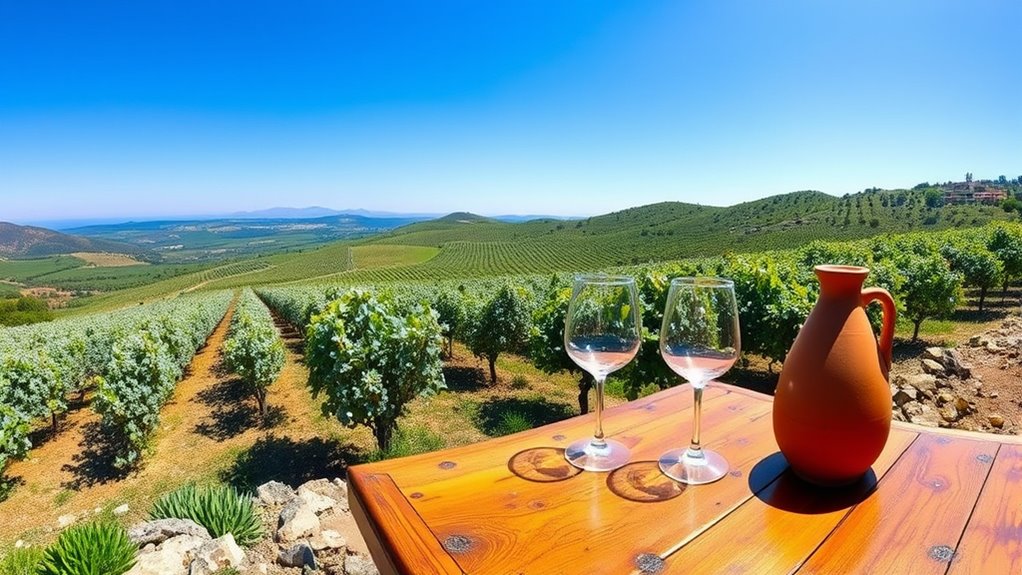
The distinctiveness of Vermentino di Gallura begins with the region’s unique terroir, shaped by its geological, climatic, and environmental features. You’ll notice the ancient granite rocks and weathered sandy soils that dominate the landscape, creating poor water retention but ideal conditions for vines. The Mediterranean climate, with abundant sunshine and cooling sea breezes, ensures grapes ripen slowly, preserving acidity and minerality. Mistral winds help prevent fungal diseases, while microclimates at higher altitudes enhance flavor complexity. The salty, briny air deposits mineral nuances onto the grapes, adding depth to the wine. The role of soil composition influences the mineral profile and overall character of Vermentino di Gallura. DNA testing suggests Vermentino’s origin from Corsica or Sardegna, and the vines often use traditional albarello trellising to withstand winds, and the natural surroundings—forests, parks, and diverse flora—support biodiversity. This terroir produces Vermentino di Gallura’s signature freshness, aromatic richness, and characteristic minerality.
Tasting the Fresh White Wines of Alghero and Anglona
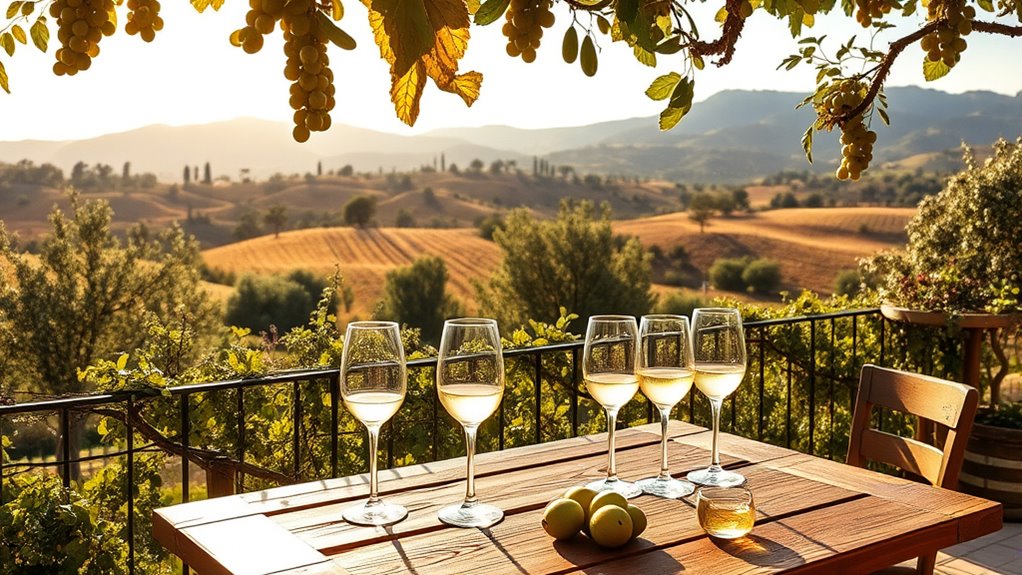
Tasting the invigorating white wines of Alghero and Anglona reveals a vibrant expression of Sardinia’s coastal terroir. In Alghero, the wines are typically light, straw-colored, with subtle minerality and salinity from sea breezes and mistral winds. Torbato-based wines showcase floral aromas, white flowers, and mineral hints, available in still and sparkling styles. Versatile blends balance aromatic complexity with revitalizing acidity, perfect for seafood. In Anglona, Vermentino dominates, offering crispness, aromatic intensity, and minerality, complemented by native varieties like Nuragus and Torbato. Both regions benefit from the Mediterranean climate, producing wines that emphasize freshness, floral notes, and coastal influence. Modern winemaking techniques preserve aromatic purity, making these whites lively, expressive, and ideal for enjoying with local seafood. Additionally, these regions utilize advanced winemaking techniques to enhance the wines’ aromatic profiles and preserve their freshness.
Pairing Northern Sardinian Wines With Seafood

Northern Sardinian wines like Vermentino di Gallura are perfect matches for local seafood, thanks to their minerality and aromatic complexity. Their bright acidity and fresh character help balance the richness of dishes like shellfish and seafood pasta. By pairing these wines thoughtfully, you’ll enhance both the flavors of the seafood and the region’s culinary traditions. Their unique qualities are further enhanced by the region’s terraced vineyards and Mediterranean climate, which contribute to their distinctive profile. Additionally, understanding the local food and wine pairing principles can elevate your tasting experience even further.
Vermentino’s Seafood Harmony
Vermentino di Gallura’s crisp acidity and saline minerality make it an ideal match for Sardinian seafood, highlighting the island’s rich maritime flavors. The wine’s mineral-driven profile balances briny shellfish like oysters, clams, and fried calamari, enhancing their natural invigorating quality. Its citrus notes of grapefruit, lime, and green apple brighten dishes such as seafood risotto, prawn linguine, or grilled prawns, creating a vibrant pairing. The wine’s herbal and salty nuances complement dishes with fresh herb sauces or seafood seasoned with Mediterranean herbs, tying the flavors together. Vermentino’s clean, revitalizing character also acts as a palate cleanser, allowing you to fully enjoy each bite. Its versatility makes it a natural partner for the diverse, seafood-centric cuisine of northern Sardinia, embodying the region’s coastal culinary spirit. Vermentino’s ability to pair well with a wide range of seafood dishes reflects its status as Sardinia’s signature white wine. Additionally, its flavor profile is shaped by the region’s unique climate and terroir, making it especially suited to complement the local seafood varieties.
Acidity and Freshness Balance
The delicate balance of acidity and invigorating qualities plays a vital role when pairing Sardinian wines with seafood, as it enhances both the wine’s vibrancy and the dish’s natural flavors. Nuragus, with its high acidity and light body, offers a crisp, revitalizing profile that complements citrusy or fresh seafood dishes perfectly. In northern Sardinia’s limestone-rich soils, Nuragus wines develop extra salinity and minerality, boosting their pairing potential. The region’s Mediterranean climate, with diurnal temperature shifts, helps preserve this acidity, ensuring wines remain lively and energetic. Whether in still or semi-sparkling frizzante styles, Nuragus’s crispness accentuates seafood’s delicate qualities. Proper beneficiary designation is essential to avoid costly tax liabilities and ensure the optimal benefits of your wine investments. This harmony elevates your dining experience, making the wine a true partner to the flavors on your plate.
Regional Culinary Pairings
Pairing Sardinian wines with seafood highlights the region’s vibrant culinary traditions and diverse wine styles. Vermentino di Gallura DOCG, the most prestigious white, pairs perfectly with delicate shellfish and oysters thanks to its crisp, mineral, and citrus notes. Lighter, fruitier Vermentino complements grilled fish, octopus, and seafood pasta, while Nuragus works well with light seafood salads and fried calamari. Semidano, a rare medium-bodied white, pairs nicely with simply grilled white fish. For spicy seafood dishes, sparkling Moscato‘s floral sweetness cuts through richness. Although red wines are less common, young, light Cannonau can surprise with sardines or tuna. Overall, unoaked whites like Vermentino and Nuragus, along with sparkling Moscato, harmonize best with Sardinian seafood specialties. Vibrational energy can also influence the enjoyment and pairing experience, enhancing your culinary journey.
Visiting Renowned Wineries in Northern Sardinia
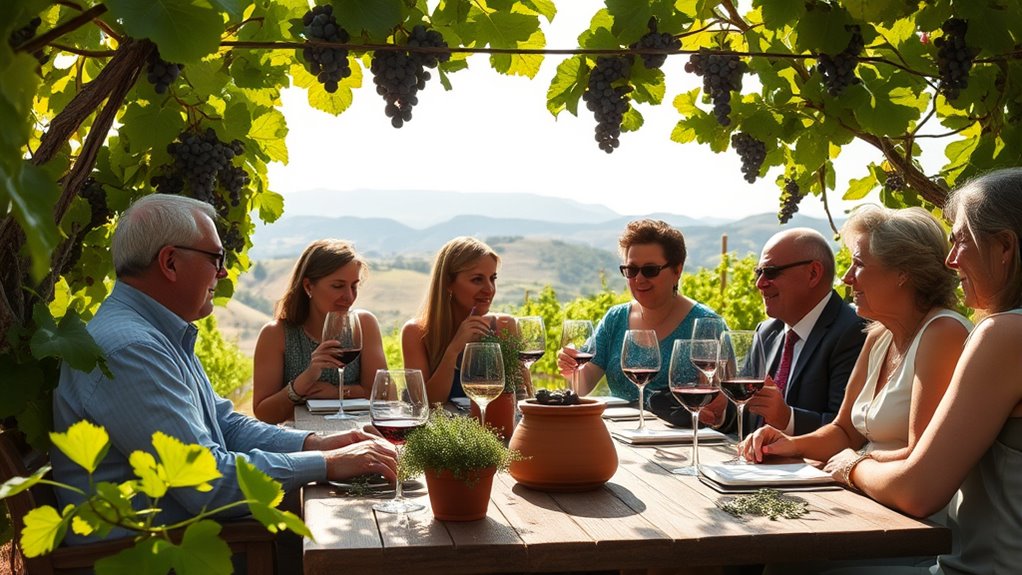
Exploring the renowned wineries of northern Sardinia offers an authentic taste of the region’s rich viticultural heritage. You can visit prestigious spots like Cantina Santa Maria La Palma, Capichera, and Vigne Surrau, each showcasing unique Sardinian wines. In Gallura, especially near Arzachena, wineries focus on Vermentino and indigenous grape varieties, blending tradition with innovation. Many wineries are family-run, with decades of winemaking experience, and offer tastings by reservation, usually Monday through Friday. At Capichera, you’ll experience the pioneering spirit behind barrel-aged Vermentino, while Vigne Surrau emphasizes quality wines reflecting local terroir. Tours often include explanations of grape varieties, traditional techniques, and regional history. Pair your tastings with local delicacies like pecorino cheese for an immersive experience in Sardinian winemaking. Additionally, some wineries incorporate modern agricultural practices to enhance wine quality while respecting the environment.
The Role of Soil and Climate in Wine Character
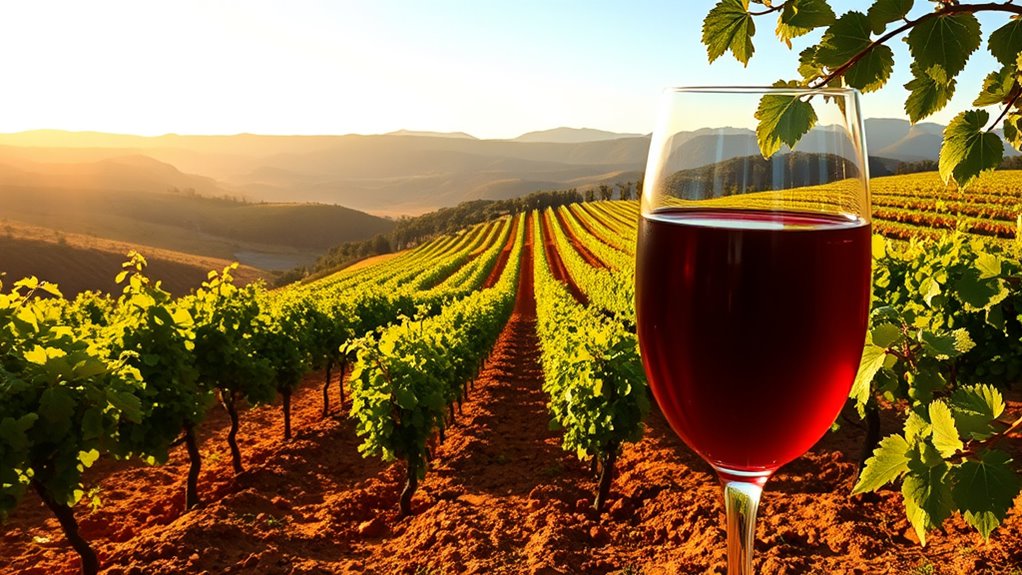
Soil and climate play essential roles in shaping the distinctive character of northern Sardinian wines. The vineyard’s soil composition influences flavor and structure, from granite’s minerality to limestone’s complexity. Clay soils retain moisture, fostering richer fruit, while sandy and alluvial soils produce delicate, nuanced wines. The heterogeneous soil mosaic creates micro-terroirs, giving varieties like Vermentino and Cagnulari unique expressions. The region’s volcanic soils also contribute to the mineral complexity of some wines. Climate features further define wine profiles. Hot, dry summers and mild winters challenge vines, but maritime breezes help moderate heat. Rising temperatures and droughts cause production drops and stress. Regular rainfall and occasional hailstorms impact growth.
- Granite soils add minerality
- Limestone enhances acidity
- Clay produces richness
- Micro-terroirs diversify flavors
- Breezes preserve freshness
Discovering Small-Batch Artisanal Producers
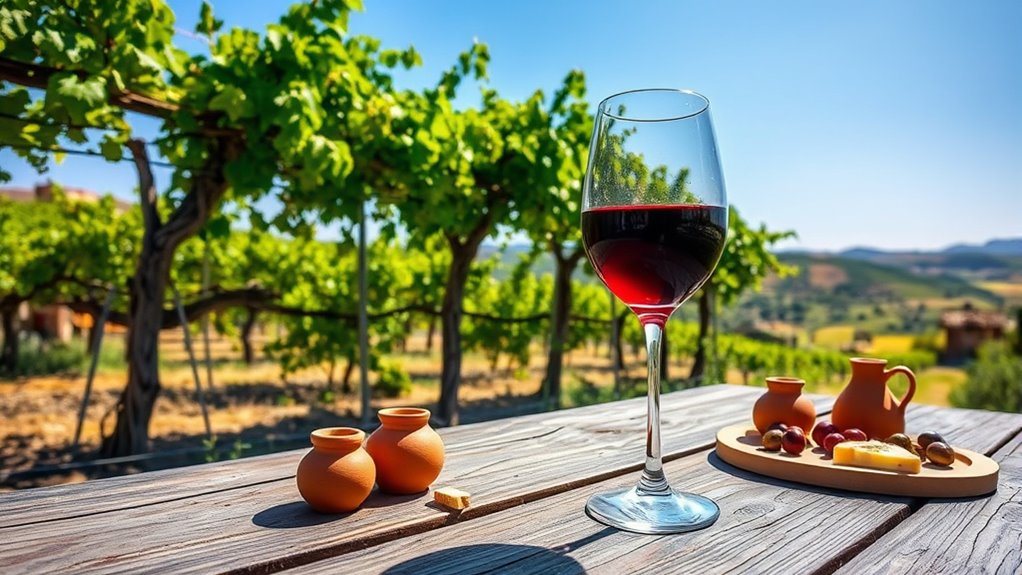
Have you ever wondered what makes small-batch artisanal wines in northern Sardinia so special? These producers focus on quality, often working with limited hectares and low yields. For example, Vini Mura produces just 60,000 bottles annually, emphasizing craftsmanship over quantity. Olianas employs biodynamic methods, using clay amphorae for fermentation and avoiding chemicals, relying on natural conditions. Cantina di Calasetta and Sardus Pater highlight traditional varieties from old vines on remote islands, showcasing unique terroirs. Boutique wineries like Antonella Corda combine family tradition with innovation, creating high-quality, limited production wines. Many of these producers operate on a small scale, often by appointment only, making each visit exclusive. Their dedication to artisanal methods and regional expression results in wines with authentic character and a true sense of place. These efforts are supported by regional initiatives promoting sustainable and organic practices, further enhancing the wines’ regional expression.
Navigating the Local Wine Appellations and Classifications
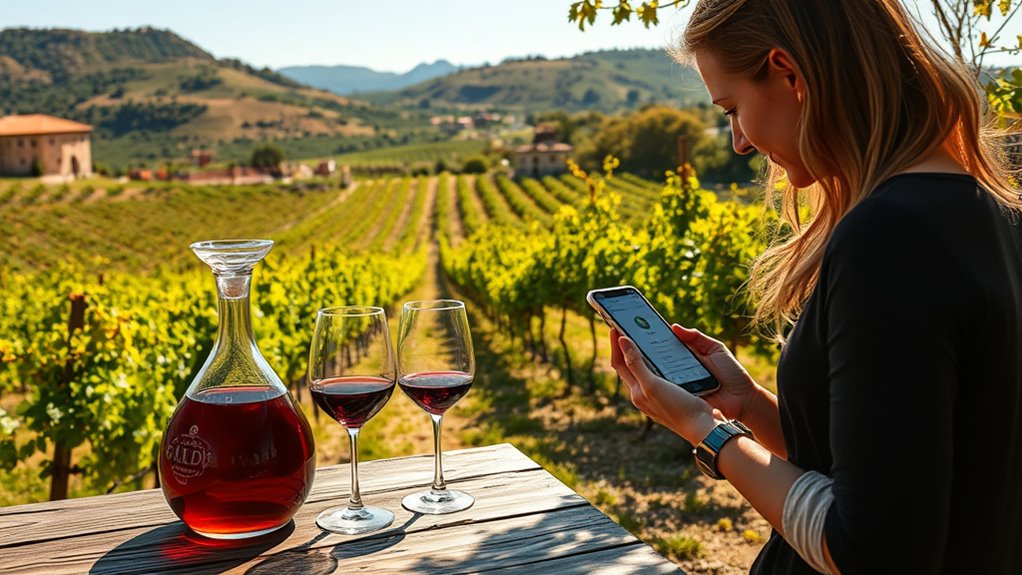
Understanding the local wine appellations helps you appreciate the quality and regional differences in Northern Sardinia. You’ll notice how hierarchy and standards, like DOCG, DOC, and IGT, influence the wines’ character and production rules. By familiarizing yourself with these classifications, you can better navigate the diverse offerings and select wines that match your taste. These regulations ensure that each designation maintains specific standards and reflects the unique terroir of its region. Recognizing the classification system also aids in understanding how traditional practices are preserved through these standards.
Appellation Hierarchies and Quality Standards
Exploring Sardinia’s wine appellation hierarchy is essential for appreciating the island’s diverse quality standards. You’ll find a clear structure from DOCG to IGT, each with specific rules. The DOCG, represented solely by Vermentino di Gallura, signifies the highest quality, with strict vineyard and production standards. The DOC level includes 17 appellations, guaranteeing regional authenticity and traditional practices, like Vermentino di Sardegna DOC covering the whole island. IGT allows more flexibility, encouraging innovation with international and local varieties. Key points include:
- DOCG guarantees top quality with strict rules
- DOC ensures regional authenticity and traditional practices
- IGT promotes experimentation and new styles
- Grape blend requirements vary by appellation
- Market statistics reflect Sardinia’s diverse production
Understanding this hierarchy helps you better appreciate Sardinian wines’ complexity and heritage. This classification system provides a framework for discerning the different levels of quality and tradition across the island’s wine regions.
Regional Classification and Variations
| Appellation | Key Characteristics |
|---|---|
| Vermentino di Gallura DOCG | Premium whites, granite soils. This area is renowned for its expressive Vermentino, which benefits from the region’s unique geological features. |
| Vermentino di Sardegna DOC | Coastal minerality, broad area. The wines often showcase a fresh, saline quality influenced by the maritime climate. |
| Torbato DOC | Aromatic, rare indigenous white. Torbato is a distinctive varietal with aromatic complexity, cultivated in limited quantities on Sardinia. |
| Cannonau DOC | Red blends, Mediterranean influence. Cannonau, Sardinia’s flagship red grape, reflects the warm climate and traditional Mediterranean viticulture. |
| Mandrolisai DOC | Red blends, volcanic soils. The region’s sandy-granitic slopes produce well-balanced, often affordable, red blends, with production from Mandrolisai being around 13,000 cases annually. |
Enhancing Your Experience With Guided Vineyard Tours
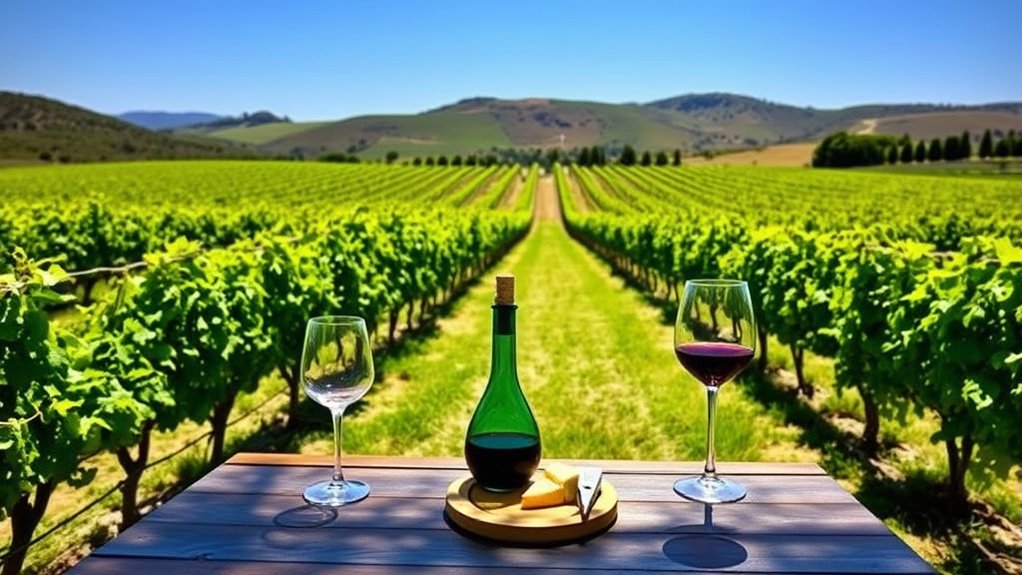
Guided vineyard tours in northern Sardinia transform a simple wine tasting into an immersive experience that deepens your appreciation of the region’s rich viticultural heritage. As you walk through vineyards and olive groves with knowledgeable hosts, you gain insights into vine cultivation, grape varieties, and winemaking traditions. These tours, typically lasting around two hours, include expert commentary and opportunities to ask questions, enhancing your understanding of local techniques and terroir. They also offer scenic views of rolling hills, coastline, or historic villages, creating a memorable sensory experience. To make the most of your visit:
Experience northern Sardinia’s vineyards and olive groves with guided tours that deepen your appreciation of local wine traditions and scenic landscapes.
- Join during the late afternoon for cooler temperatures and golden lighting
- Reserve in advance, especially for smaller groups
- Wear comfortable footwear for uneven terrain
- Choose guided tours with behind-the-scenes visits
- Engage directly with estate owners and winemakers
- Knowledge of local vineyards and winemaking techniques can greatly enrich your tour experience.
Savoring Sardinian Cuisine Alongside Local Wines
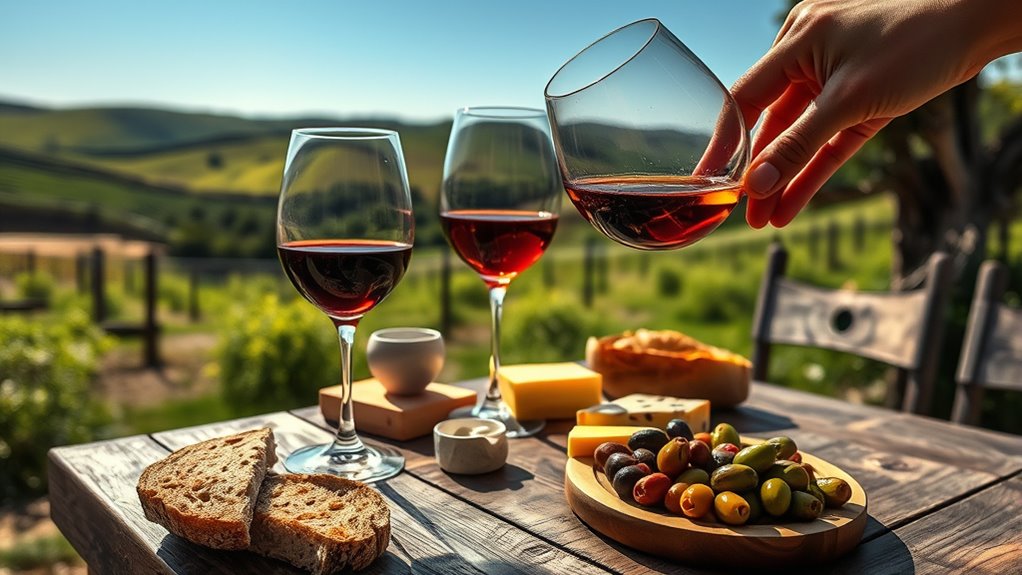
Sardinian cuisine offers a perfect match for the region’s wines, especially seafood paired with Vermentino. The crisp, aromatic whites highlight the freshness of shellfish, clams, and fish dishes, making every bite more vibrant. Exploring these pairings enhances your tasting experience and reveals the island’s rich culinary traditions. Traditional ingredients and culinary styles further complement the regional wines, creating a harmonious balance that celebrates Sardinia’s unique flavors.
Pairing Seafood With Vermentino
Pairing seafood with Vermentino is a natural choice that highlights the wine’s vibrant acidity and complex flavors, enhancing the freshness of Sardinian seafood dishes. Its high acidity, citrus-herbal profile, and saline minerality complement the sea’s natural saltiness, making each bite more vivid. The wine’s aromas of lime, grapefruit, and sage amplify dishes with Mediterranean herbs and lemon. Its medium body and structured acidity balance richer, oily seafood like tuna or mackerel, while its crispness refreshes lighter options such as shellfish or white fish. Most Sardinian Vermentino is fermented in stainless steel, preserving freshness essential for pairing. To optimize pairing, serve Vermentino slightly chilled, and match it with dishes featuring herbs, citrus, or seafood prepared simply yet flavorful. Vermentino is predominantly produced in Sardinia, where the Mediterranean climate and calcareous soils contribute to its distinctive character. – Emphasizes the wine’s saline mineral notes that mirror the sea’s saltiness – Balances oily fish with high acidity – Enhances dishes with citrus and herbal ingredients – Cleanses the palate after fried or grilled seafood – Complements both light and richer seafood preparations
Sardinian Culinary Traditions
The vibrant flavors of Sardinian wines naturally complement the island’s rich culinary traditions, creating a harmonious dining experience. You’ll find that bread like Pane Carasau and Pane Frattau forms the base of many dishes, often paired with Pecorino cheese, which enriches soups like gallurese or pane frattau. Meat plays a central role, especially pork and lamb, featured in roasted porceddu or stuffed panada. Fresh herbs such as rosemary, myrtle, and thyme flavor these dishes, while vegetables like broad beans, cabbage, and fennel add depth. Traditional plates like porceddu, fabada, and hearty soups highlight rural and pastoral roots. Combining these flavors with local wines elevates the experience, showcasing Sardinia’s unique culinary heritage and vibrant, rustic spirit. Pane Carasau, known as “Carta da Musica” due to its thin, crispy texture, also pairs wonderfully with local wines, enhancing the tasting experience.
Frequently Asked Questions
What Is the Best Time of Year for Wine Tasting in Northern Sardinia?
The best time of year for wine tasting is during the early autumn months, mainly September and October. You’ll experience the freshest wines, freshly pressed and fermenting, and can enjoy harvest festivals and open-cellar events. Visiting then allows you to see traditional winemaking firsthand, participate in grape picking, and enjoy lively celebrations. Just remember to book ahead, bring sun protection, and embrace the vibrant, bustling harvest atmosphere.
Are Wine Tours Suitable for All Ages and Wine Knowledge Levels?
Imagine you’re stepping into a Renaissance painting, where every detail matters. Wine tours are generally suitable for a range of ages and knowledge levels. Kids under four get soft drinks, while older children can enjoy family-friendly activities. Adults and wine enthusiasts can indulge in tastings, guided explanations, and vineyard walks. No matter your experience, you’ll find tours that educate, entertain, and suit your needs, making the experience accessible and enjoyable for everyone.
How Do I Identify Authentic Vermentino Di Gallura DOCG Wines?
To identify authentic Vermentino di Gallura DOCG wines, look for the DOCG seal on the label, which guarantees origin and quality. Check that the wine is a clear, intense straw yellow with greenish reflections. Smell for floral, citrus, and tropical notes, and taste for a dry, balanced, mineral-rich profile with a slightly bitter, salty finish. Authentic bottles also typically have vintage info and are served at 8-10°C.
Can I Purchase Wines Directly From Wineries for Home Collection?
Think of buying wines directly from wineries as revealing a secret garden—full of exclusive treasures. Yes, you can purchase wines directly for home collection in Sardinia. Many wineries welcome visitors, offering on-site purchases of limited-edition bottles and online orders with home delivery. This way, you enjoy authentic Sardinian wines, support local producers, and get personalized service, all while bringing a piece of Sardinia’s terroir to your door.
Are There Any Local Festivals Celebrating Sardinian Wines?
You’re curious about local festivals celebrating Sardinian wines. In Northern Sardinia, you’ll find several events, like the Porto Cervo Wine & Food Festival, which showcases Sardinian and international wines with tastings and masterclasses. The Alghero Wine Week highlights local wines amid cultural activities, while the Bosa Wine Festival focuses on regional traditions. These festivals let you immerse yourself in Sardinian wine culture and enjoy unique tastings.
Conclusion
So, next time you wander northern Sardinia, don’t just sip blindly—imagine yourself a daring explorer in a sea of white wines, battling the waves of Vermentino and conquering the tiny artisanal vineyards. Pair your conquest with seafood, and you’ll feel like a gourmet pirate sailing through flavors. Just remember, in Sardinia, even the wine has a story, and you’re the brave storyteller. Cheers to your flavorful adventure!
